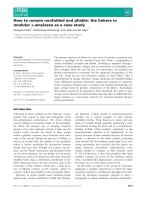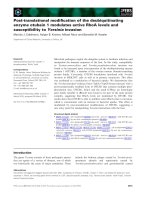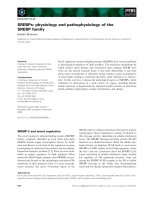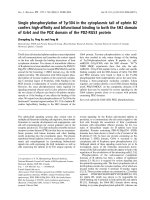Báo cáo khoa học: "SOLUTIONS TO ISSUES DEPEND ON THE KNOWLEDGE REPRESENTATION" ppt
Bạn đang xem bản rút gọn của tài liệu. Xem và tải ngay bản đầy đủ của tài liệu tại đây (258.94 KB, 3 trang )
SOLUTIONS TO ISSUES DEPEND ON THE KNOWLEDGE REPRESENTATION
Frederick
B.
Tho~psoH
~li£orni~ Institute
o£ Technology
Pasadena,
C~,li?orni~
In orpQnizing This p~nel, our
Ch(tirmon, Bob Moore, expressed the view
thor too often discussion o? Hoturra'l
l,',nguage
occess To
dol'o
buses has focused
on
whot
p~rticulc~r
systems c~*n
or
cQnnot
do, ro'ther than on underlying issues. He
Then sd~irr4bly proceeded to orgonize the
prJnel nr. ound issues
r-qther th~n
systems.
In responding, I qttempted to ?rr.iMe
my
~'emr~rk~,
on
e,ach o? his five issues in r~
gener~l woy
that would not
reflec~
~y ,wn
pr4rochiul experience qnd interest, At one
point I thought th~.~t I h~d s,cceeded quite
well. Howe,.,er~ offer t~king a cleorer eyed
view~ it wqs
qpparent
thor
my
remarks
reflec~c;d
~ssumptions obout knowledge
representotion
theft
were
by no
Meons
univers~ol. This suggests ,a
sixth
issue
which I would like
~o r~omin~t,.,:
Are there
r'eolly
useful generolizNtions
~bou~ comput~Jtionr~l linguistic issues
th<~t c~r,e independer~t of r~ssumptions
concerning
knowledq,.~
r'epre.sentcition?
I will come back
'to
this sixth issue
q?ter discussing t'i~e ?ire cho-~.,n by our
Choir~or,.
I ~s~,e
@i
: A.q.ctreq~te_ F.~nc.t i
o ns qnd
~uon.!i.S.~.
F'irst~
let
us
csst
this issue in o
~omewhot di.fferent way, Irl m~.sny
d~tc, b~se
~:ituo.1io~s., there ,',r'e closes of
individuals olI of
whose
Me~bers shcire the
~.:oMs ot'~ributes ~and thus, ÷'rum the point
of view o.f the dr~'t~ bose~ ,ir~
.~.ndi~tJ,vuish,~ble. 'Thus there is no need
~o
~dd
,*II
of the~.~. ,
individuals Qs
~':.e. prw, o't(~
entities,
To use
Bob
Moore's
ex,a~ple., i? ,:z DEPARTMENT tile
h~
,.~ ~ield
Cur NUMPER"OF-EMPL.OYEES~ it strands To
r'~~,.~on th~L~' the pczr!icul~:~r [ndividu~.~Is ;~ho
~c~uolly existed in
the v,ar'ious
dep~r't~tHH~'~
would r~o~ be
s~ep,ar,~tely
r'~pr'e,>~:~,~ed
in
the.
dc~~obose
(for
uther'wise
there would be o redund,.~ncy whose
, :or1~J' :'~.;nc,./
would
be
h~r'd to police),
In
~u,-'h
:~i~u,:~io~s
we
need the. notion of ~'~
",~olleL'ti,~e," homely ~a
single
dr~tr~
b,ase
object ~'hot ~,.,l(e~
the;
pl~.'~c~,
of
ra number of
.ir~divid~.,r, ls
end which c,~r~
c,ar'ry their
cot~on ,~r!'r.Lbul'e~ together with one
,'~ddition,il item o? in~'ormotion,
nomely
~heir r~umber, Thus ~ DEPARTMENT could
h~ve ~s o single ~ember su,:h ~ collective
,.,f employees, indeed it could hove severQl
such collective MeMbers ond other
indiuidu~l
MeMbers ~s well. The procedure
thor is c~11ed when onswering "how Mony"
~nd "nu(~ber of" questions would know the
dif?eren(-e between subcl~s,~es, indiuidurJl
(~eMber~ r~nd collective ~embers~ it would
know to recurse on subclc~sses, ~.~dd one to
its coun'~ for individual MeMbers ond odd
the
indicoted'
number" to
its
count-for'
collec:tJve MeMbers. This ~ppe~rs To be
uni?ied ?r,~ework th,,t will h(1~d].e ,~11 of
the c:~s,e~ mentioned in Bob Moore's
stQtement
o?
Issue #I.
Issue '~2: .T,,iM,e, qnci T_e_p._s_e
I should like to split this issue into
two, The ?irst sub-issue is the problem of
hondling continuusly varying phenoMeno>
~.~uch ra,:,
1he MoveMent of ships~ the
chqnging
of
relotiv,.,
~zMount,:~ of
ingredients in che~ic~l reQc~ions~ or "the
percent completions o9 tnsks, Here it is
~pp(~rent thr~t
eoch instonce will
require s
~peci~lized procedure to hKLnflle
interpol,~tion. Ships cr~nnot s~il Qcross
Irjnd~
thus
~n interpolation procedure thor
produce~ the position of o ship on The
bdJsis
of
its
points o~' dep~u'tur~, ond
des'tinotJ, orl will need To know obout the
c0cAstlines
o?
conrinents~
Movements
to
cheMJ.c~l equilibriums. ~re not line~r~ t~sk
coMpletioNs depend on changing personnel
ossignf~ents. Just rls we coMputotionol
linguists
provide to our syste(,~ u~er the
(.opobili'¢y to introduce into his dotr~ b~se
system ~uch notion.'~
,a~
loc,=rions of"
port.~
end ship~, etc.> we Must ,also provide ~he
Met:ins by which he crarl define such
'.:ontinuously vr~ryir',~ p,ar(~meters r~s
position in such wqys th~.~t ~tpproprJ.ote
in~erpo],',tions c~zn be ~de. by ~he generol
system in con.junctioN with the p,lrtlculor
defini'tJon. For"
example,
'the
user
mr~y
de?ine~ "position o? X" in ter~ of
('.r~lcu]:'~%ions, perhops extensive> involvin 9
~he ,~ctu~.~l 9eo~etr'y of the ~eq~.
169
The second sub-issue on which
I
would
like. to coMmen~ concerns ~hose c~ses
where discrete
~ime
intervals provide rin
r.~dequ(l~(~, r, epresentr.~tion o@ "(he time
aspects relevr, nt to the da'tq bqse. In
*hese coses~ if` ~he
time inf`orf~tion
is
coMplete~
i,e,,
rictu(:l
st~Ir~lng
~nd ending
rimes of`
rill
events ripe
recorded
in ~he
d~tQ b,~se, the h~ndling o? time is rrither
strriightforwrird, However this c~se of"~en
does not ripply, Consider the ?allowing
e xQmp], e.
:
"The Ki~tyhriwk ~rrived in London Monday,
The Mriru will soil ?ram London Friday.
Will th~ Kitcyhowk ~nd Hrir'u h~ve been in
London ~t the s~e time?"
One is
teP~pted ~o
ollow the
computer
lo
give q
response: "Possibly,"
however
the introduction of` a three uolued logic
is Tr'qught with well known d~ngers of" its
own, A More protrricted response gets in
the way o~ clnuse [~bedding; how does one
hrind].e~
"Will
si~ips
thrit have been
in London
together
sriil
together?"
One
rins~er would
be:
"The Ki~i'.vh~.~wk rirrived IriF~t Mondc~y~
the Mor, u
will soil
next
Friday,
I~
they
will
hrive b~.en there
qt
the same
~iMe~
then
not
rill
ships ~hr~t were in
London together will sriil 1'ogether~ bu~
they
v:ould
be
the only exceptions,"
Choosing ~ relev~mt dic~gnosti,:
t,eessoge~ os obove., is o Mrijor r~nd
di£?icul't coMputotion,:~l liguis~c issue
(:~oing
w~],l
beyound questions
concerning
t iMe ~lII,J
*,ense,
Issue
%3 :
_~_~r.ULi.f,,.! i.]:Lg
~,p_xo ~u.esx
ions
This i~
a deep~
philosoph[c,ll
ques'~io,~. CoMput~,i. onol
linguists
hove
pr, ogrw:s~ed beyond tl'w. ,:onsiderqtion o?
~:~ing].e ~,.~'ntences,
r~nd
rire seeking
~o
,?ollow ~che 'focus of
,]
dirjlogu~. ~
(And
iden'ti.fy
'the
theme
o? ~
discourse,
This
is
ev~.r}~uqlly ,4n
infinite
regr'e,~ ultLMritely
invo].vi~g
cross
cul~'ur~l
brickgrounds,
~he
(perh~/ps
Mc, chiclvellion>
irlt,~.n~ o~ those
,.,,ha co~,trol ~he u'~e
oT o
particular
ctpplicr:~Lon;.
,:It,
Dv~: the
eng.i.neering
prob].ef~,
c~ le,~s'r ~
~he present eta're o£
• the
c~rt,, i~
:~Lapl~_:
whr, t
response
is
~os~
:Jse£u] "~.o
~'he use.r? Consider
kwo
possible
(n~swers ~o ,.'he Following question:
"Who ,.~on,.'~ges
ec~cl~
deportment?"
Ai:
"No single person M~nages ~ll o~
the depor~Ments,"
dept. A ~rin~ger
A
Unless ~here were ~n undue number o~"
dep~rtMents involved~ the second is
(.Ice, Ply prei~erred~ ?or
it ~uf`f`ices
"even
i?
the f`irst were intended,
I.
our own
experie.,ce, "e~ch" con usefully be
in'terpreted
,~s
coiling
~or ~,
l~b~.led list
,~s
onswer in
~l~ost oll coses, The
diff"icul¢ies of" being t~ore clever
ore
great
arid will o~°ten
result
in
coMbinqtori(ll explosion, I (~M
sur~.,
for o
]ong tJi~e
into
the future,
we will
be
seeking simple
solutions that (?.~) ore
respon,~,ive in
Mos~
c(~ses> (b) provide the
needed inforMr~eion~ even though redund~nt
Jn SOMe cGse~
rind
(c) M~ke c:lerir
the
Misinterpre~rition
in
the
£ew
c,~se where
this
rirjses, even though
these
solutions
May
violrite strict
linguistic
rinqlysis,
Issue
#4 :
~4e_.,r
vi.n~ ~.eM~n~ ic~.!_l y_
CoMp ke
X
In presenting i~his issue Io the prlnel~
Bob Moore used the ?ollowlng three
questions ris ~n example:
"Is
John Jones
(, child
oF
rln HIT
rll U MIIU ~- ? "
"Is one o£ John ~ones~s p~rsnts on HIT
(ll u~)n u.~ 9"
"Did e.i'~her poren~ o~" /ohn ]ones t~ttend
HIT?"
The
appqre.t problem is 'the
po.~sibilit~,, of" Multiple des(-rLptions~
o~'ten
involving
dispor'rite
words~
.For,
getting
~lt dril:t,
in
~he
datri h~se, In
(.JeBicjrlillg
our" systems)
we recognize two
tru~h~
which ~ppe,~r'
to
con,flick: (q)
the
v~lue o.F MiniMizing the reduhdrincy o£
.LnforMf~tion in the dqt(t b,1~e. (b) the
necessi-iy
o£ non-independent words
in the
vocobulr~ry,
In
our' own work~
,~s
Mo.~t o?
you know, we hove stressed the use
o?
definitions c~s
u Me~zns
of
,'Ich.i.eving o
synthe~i~ oF
'~-hese
*.wo princ:iples. I
recoMMe.d it to you u~ ri v~.r~ o~p.i~ul tool
in hondlino problems like Bob presents. We
illustrate
how Bob~s excLMpl~;
c,.~n
be
hr~ndled
:
"de'fini~ion'child:converse o~" parent
ve.rb:John ",;it~end"~ HITmJoh. is
' 'tud~.t,~
o?
HIT
dei'~inition:~lu~,r-'s'person who hod
been ~ student"
170
The
ubove
three questions then
ore
?.~n~1 y zed ~s:
"3"ohn )ones
is
(converse
o? parent)
o?
a
person
who
had been ~ student
of
HIT?"
"One of
~ohn
/ones's
parents
is a
person
who had been a student o-t HIT?"
"W~s
ei'ther parent o£ ~ohn ~ones
a
student of HIT?"
I do not wish to slur' over' the fact
that ~.=
definition Mech~.,nisM
~ust be
hifhly
:sophis~'~coted in i~s handling of f'ree
variables,, bu~ our ~xperience i~dic~*te.~
tha~ ~l'~s can be done quite
s~tisfac toril y.
Issue
#5:
Hu~ti-Fil#._~uer'ie_.s
This issue has been
stated
by Bob in
terms of G tr'~dixional Multiple file de=to
b,~se s'tructure, This issue h~s its
coun'ter'p~rt
in seM~intic
neT data.
base
structures discussed
in pr4per,~
on
k~ow].edge representation, Since we use
such q semantic net s~ructure
For,
our
data, le't me rephrase the issue in those
~erMs. In Dab's st~tteMerlt of the issue~ he
uses tl'~ example
of
the
SHIP
file and the
PORT .File; wl}ere the SHIP f.ile
h,~s fields
-For ho~,~¢ port, departure port and
destination port.
P,~,r'allelLnq
his
exa~p](:,
let
us consider ~h~ phrase:
"London
ship",
Suppose ~hr.~t (q)
there
w~s
ship n,~r~ed London, nnd (b) London was a
ho~e por~, port
of
depqrtur~
and
des'tir~o'~ion~ not necessarily o~" the same
ship, Then "London ship" is four ways
,~Mbifuous~ ~e~ning: (i)
the
ship London~
(2) London (ho~e port) ships, (3) l.ondon
(depr~r~-ur~z par-X) ~hips
~nd
(4) London
(destinq~ion port) ~hips, In this
for~ul~tion of
the
probleM~ ~II
is
easy~
insofar ~ the phr~s~;
"Londo,
ship" is
not
'.iisc~Mbigu~Ted
in
con'text~ the user is
informed
o?
the ~lMbiguous M~lrlincjs (Ind the
,~ssoci,:~'ted responses. The difficulty
urises
when There ar'~.
pos.~ibile
.i.nterpr,.'<'~'ations
?,~r~her (~field,
Fort
Collins is
n,.~.itl')er
,~
port
nor ~ ship~
however ~.he
headqunr'ters of
the
ABC
Sllippirt,# CoMpany
i~
there un,:l they own
~everol
ships.
Wh,~'t
?~r'e
we
~o ~e~n
by
"For"t
Collins
.~hip"?
The.~e ~u-e
pr'obleM~
tha't wer.e ?irs~ ~1'*:acked by
Quillicm, and
f
qM not ~ur'e ~'t~(~'t unyone I ~.~ c~dded
to
hi~
!=emii~ol ~r~r~ly':sj.s o£
lhe~,
In
our
own
work~
we
he*re
s~uppecJ
at "once
re~-1oved"
,.:onnec.'tJons.,
,:~ il].u~r~zTed by
the four-
w~,~y ,~mbiq,)ity
,Ibove.
Issue
~6:
Solution~ tO. Is~q.es_._D~.~.n
As
I look back on the abuv~ reMork~
t:oncerning Sob's
five
issues~ it becomes
~pparent
thr~t the u.~efulness
of
these
remarks
depends
on
The degree one is aware
of the
knowledge
representatLon that
underlie.s the solution suggested, For
ex~Mple~ in the case of the last
,Ls~ue,.
il ~
one only knew about traditional file
structures~ finding paths theft link fields
in More Than one file appears all
but
unsolvable, Even
if
one is accustomed to
semantic
net
structures~ the
viability of
finding connective pnth.~ is highl~
dependccn~ on the
existence of back links
between attributes and their ,~rgu~en~s and
values. Adding a definitional capability~
other
thun
simple abbreviqtions
~md
synonyf4s~ Burns on the
way free variables
ore handled
in
9ener~Jl
cmd on the
opporo.tus +'or binding theM) for example,
in processing the de+'inition:
"dei~]nition:are~:length times
width"
when applied ~o q class> say "areas of
;~hips", how does one ensure ~hat he will
ob rain
:
"lengTh(i) ~k width(i)
fop
i
=
I
to
number
of
ship~"
rather Thonl
"lengTh(i) ~ width(j)
?or i~j = i to nut.~ber o? ship =.?"
It coMe~ down to how variables qre
MainTained in The underlying knowledge
represen'tat ion,
One is £or'ced to conclude ~hat the
basis ~'or the integrcltion of the syntax
cu,d ~emonTics o? coMput,~tionr~l linguistic
systems
i~ -ccoMplished wh n
tile
d¢ci~4ion~ on knowledge r'epre~en~tiun ~r'e
Made, Di~Jcussions 0£ #ur
w:~rLous
sotut.En.n
to ~he J~sues of coMputaTional linguistics
can Meaningfully ~uke
pl<~ce
only in terM~
uf the,:,~ underlying knowledge
repr'eser~tot ions.
171









